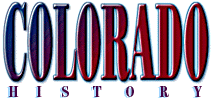
|


|
|
|
Mr. Sedivy's
More Features: |
Highlands Ranch High School - Mr. Sedivy
- Colorado History - Pikes Peak or Bust Pikes Peak was scaled by three other explorers just 14 years after Zebulon Pike said it couldn't be done.
"Pike's Peak or Bust" was the rallying cry painted on the canvas wagon tops, and it was leading the gold seekers to the wrong place. The first gold rushers to Pike's Peak discovered that there was no gold to be found within 100 miles of the peak.
In early May, as the frontier towns swelled with outward
bound gold rushers, there was an opposite wave of inward bound disillusioned
gold seekers passing through the towns on their way home. Their wagons
now had the Pike's Peak slogan crossed out and under it was hastily
scrawled:
Pikes Peak was usually the first landmark seen by the new settlers as they made their way across the praire. Only lucky wagon trains got through without being attacked by marauding Indians. Even large parties with lots of guns and arms were often harassed. No one counted how many prospective miners died en route to Pikes Peak, but the casualties were appalling.
Colorado Goild Rush - 1859 What started in California with the '49ers - the first miners and prospectors who rushed west in search of gold in 1849 - continued further east in the following two decades, when gold and silver strikes were made in the territories of Colorado, Nevada, and Arizona. When the forty niners traveled cross-country in their wagons they abandoned useless objects on the way to the gold rush. In contrast, the early "fifty niners" trashed the plains returning home. Among the many discarded articles were optimistic guide books of the region written by D.C. Oakes. He went from hero to goat in several months. He was so disliked by the disenchanted gold rushers that they erected a fake headstone with a rhyme inscribed upon it: "Here lies the body
of D. C. Oakes,
The gold strike in the Colorado Territory by John Gregory in 1859 revived the Pikes Peak rush.
William N. Byers, publisher of the Rocky Mountain News, printed poems like the following: "The gold is there,
'most anywhere Then ho boys ho, to
Cherry Creek we'll go. At least Byers got the area right, although he received his fair share of criticism and abuse. Some even suggested that he and Oakes be lynched. Someone else pointed out that too many people believed Oakes was already dead and the lynching notion was not taken seriously.
To carry on their often fruitless and frustrating search for the mineral wealth of the West, prospectors required "grub" and plenty of it, as evidenced by the number of spent food tins strewn about this typical Colorado mining camp of the 1860s. Beans, flapjacks and sourdough bread were the miners' staples.
Many 1859 Pikes Peak miners did not find gold. Some
became settlers while others became "go-backers" heading
east. A sign on one wagon read: Many of the prospectors in the Colorado gold rush had been farmers. "So green," went a common saying of the day, "that they mined with pitchforks."
The Expeditions of John Wesley Powell John Wesley Powell was a Civil War Union hero who had lost an arm at Shiloh. On May 24, 1869, Powell set out to traverse the entire raging Colorado River system by boat from the Green River in Wyoming to the Virgin River of Nevada with Army surplus supplies and three oak boats built with his own money. His party of ten men was reduced after three members left to return home on foot and were killed by Indians on their way.
They passed through the entire length of the Grand Canyon and emerged three months later as national heros. Powell completed the journey on August 30 and returned home to great acclaim. In 1871 he did it again. Powell later went on to head the US Geological Survey, but he will always be best remembered as the one-armed explorer who dared to challenge the Grand Canyon and the mighty Colorado River.
- Colorado History In Depth
- | The Cheyenne Migration
to Colorado | The Cheyenne Social Club
Fort Union Americans from the East Colorado's Role in the US Civil
War Cripple Creek District Labor Strikes More Colorado History
Information
|
Highlands Ranch High School ![]() 9375 South Cresthill Lane
9375 South Cresthill Lane ![]() Highlands Ranch, Colorado 80126
Highlands Ranch, Colorado 80126 ![]() 303-471-7000
303-471-7000
Mr. Sedivy's History Classes
| Colorado History | American
Government | Advanced Placement Modern European
History | Rise of Nation State England | World
History |
| Home | Back to the top of page
| Site Contents |















